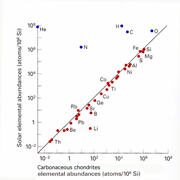Deciphering Meteorites

Enlargement
Some meteorites are older than all the rocky formations on Earth, including Mont Ararat, Turkey. |
Falling meteorites are spectacular, but the secrets they bring are even more enthralling. Two pieces of information alone make meteorites unique and fascinating rocks to study: (1) most are 4.56 billion years old; and (2) some have a composition very close to that of the Sun without the volatile elements.
Some meteorites have hardly changed in 4.5 billion years and are older than our planet. They give us information about the formation of the solar system and are examples of the first solid bodies that were formed. Others show signs of being heated, metamorphisizing, and recrystallizing. These meteorites teach us about the parent bodies of the sub-planetary mass between Mars and Jupiter.

Enlargement
To avoid contaminating the meteorites, scientists at NASA's Johnson Space Center study meteorites from the Antarctic in a sterile room. |
Meteorites also serve as clocks to date different events that occurred in the solar system. The chronometers used are pairs of chemical elements in a particular form, called isotopes. One is the product of the radioactive disintegration of the other. The proportion of the parent element in comparison to that of the daughter element tells a story: it informs scientists about the age of an event such as the creation of a body or its fragmentation.

Enlargement
This graph compares the elements present in carbonaceous chondrites to those recorded in the Sun's atmosphere. Non-volatile elements are present in the same proportions. This is not the case for carbon, hydrogen, helium, oxygen, and nitrogen. |
|